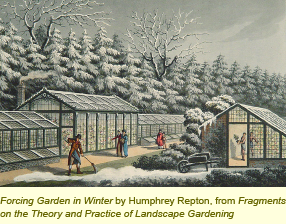Exhibitions
- May 14, 2011-February 15, 2012
Writing the Garden: Books from the Collections of The New York Society Library and Elizabeth Barlow Rogers - May 21-August 29, 2010
Romantic Gardens: Nature, Art, and Landscape Design Rare books from the collections of the Morgan Library and Museum and Elizabeth Barlow Rogers
Lectures and Symposia
- June 2, 2010
How Romantic is Now? Spotlight on Contemporary Landscape Design - May 26, 2010
Great Romantic Landscapes: Central Park and Frederic Church's Olana - January 15, 2008
How Green is My City? New York Today and in 2030 - January-April 2007
Nature and Place: A Series of Conversations with Elizabeth Barlow Rogers - January-April 2006
The American Landscape: Ideals, Influences, Innovations
The American Landscape: Ideals, Influences, Innovations
A lecture series cosponsored by the New York Botanical Garden, the New-York Historical Society, and the Foundation for Landscape Studies This series examined ways in which nineteenth-century parks, gardens, and paintings reflect the aesthetic values and practical technologies of the period.
Jay Cantor
Rural Images of America: Myth and Realities
Monday, January 23, 2006
The overarching image of the American rural landscape in the nineteenth century is largely the result of Romantic painters loosely associated under the term Hudson River School. It is, however, increasingly clear that the view these artists provided was highly selective and, to a degree, politically motivated. This talk by Jay Cantor provided a perspective on the artistic myth of the American landscape as it was recast under prevailing economic realities to fulfill the country’s nation-making agenda.
Therese O'Malley
Gardens under Glass, a Natural History of Greenhouses
Monday, February 13, 2006
 The collection of exotic plants from warm climates necessitated their protection and display in greenhouses. Concentrating on the transatlantic exchange of plants, ideas, and people, Therese O’Malley, guest curator for the New York Botanical Garden’s exhibition “Glasshouses: The Architecture of Light and Air,” discussed how this process was, and continues to be, vital to botany, horticulture, and landscape design.
The collection of exotic plants from warm climates necessitated their protection and display in greenhouses. Concentrating on the transatlantic exchange of plants, ideas, and people, Therese O’Malley, guest curator for the New York Botanical Garden’s exhibition “Glasshouses: The Architecture of Light and Air,” discussed how this process was, and continues to be, vital to botany, horticulture, and landscape design.
David Schuyler
The Sanctified Landscape: Art, Literature, and the Emergence of a Preservationist Ethos in the Hudson Valley,
1820-1850
Monday, March 13, 2006
Thanks to the writings of Andrew Jackson Downing and through the influence of wealthy individuals who built houses and ornamental gardens, the Hudson Valley became the paradigmatic American landscape.
The broader scenic context portrayed by painters, poets, and writers reinforced American taste in domestic design. David Schuyler demonstrated how this new nineteenth-century American stylistic idiom, combined with the beginnings of an indigenous historic preservation movement, fostered our self-awareness as a new nation.
Elizabeth Barlow Rogers
International Romanticism and the American Landscape
Monday, April 3, 2006
Andrew Jackson Downing, Frederick Law Olmsted, Calvert Vaux, and other contemporary landscape designers and their successors looked to England and also to Germany for inspiration and practical know-how. The eighteenth and nineteenth-century gardens and parks of England inspired and influenced these Americans while also affecting the work of such Continental designers as the Marquis de Giradin at Ermenonville, Prince Franz of Anhalt-Dessau at Wörlitz, and Prince Pückler at Muskau. Elizabeth Barlow Rogers showed how American landscape architecture was par of an important international trendsetting shift in garden and park design.
